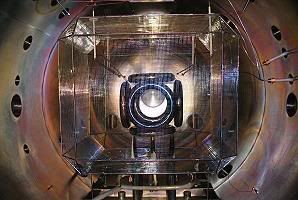Bohm,
I'll hit the points in reverse order.
The efficiency is defined according to the specific thermodynamic cycle used. (Rankine, Brayton, Sterling, Otto, Diesel, vapor-compression, etc.) However, the efficiency is always less than the Carnot efficiency (1-Tc/Th) which is the theoretical maximum efficiency of a heat cycle. It is irrelevent the type of fuel, the type of reaction, be it chemical, combustion, or nuclear, it is still a thermodynamic cycle to extract useful energy.
That is one of the beauties of thermodynamics. Without knowing anything about the process used, you can learn how much energy you can possibly get out of the thermal system based on input and output temperatures alone. This is a great solution check when analyzing a system. If the thermal efficiency of your system comes out greater than the carnot efficiency, you immediately know you calculated something incorrectly.
The closest analogy I can think of is analyzing a complex electronic circuit with Norton and Thevinin equivalents.
I won't get into too much detail about state changes, however the additional energy added is fully accounted for by the enthalpy values in a standard steam table or enthalpy-entropy chart. Basically you use constant temperatue at the given pressure and the change in entropy as the steam changes from saturated liquid to saturated vapor to superheated steam (dry steam) and find the new value of enthalpy using the thermodynamic relations. The efficiency is the ratio of enthalpies of the cycle input and the cycle output. There are all sorts of ways to increase the efficiency; superheating, regenerative heating, feedwater heaters, combined cycles, etc, but the thermal efficiency of the system is always less than the Carnot efficiency.
For the second point, since I haven't really seen what "self-sustained" mode is, who knows. Perhaps after initially heating his water source, the temperature change through the reactor is enough to offset heat loss from conduction out of the system. The system is obviously not abiabatic. He can dump the fluid back in his source tank and keep it at the original temperature. That would be self-sustaining until his reactants ran out.
Finally, I know it seems counter-intuitive because there are so many other variables involved, but in a heat cycle such as this, temperature difference between input and ouput tells you the maximum efficiency possible.

